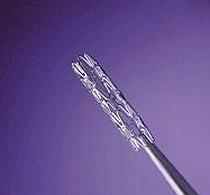This is the VOA Special English Health Report.
A coronary stent is a small tube that is used to treat heart patients. The
tube is made of wire mesh. Doctors place it inside an artery that has narrowed.
They expand the stent to hold the walls of the artery open so blood can flow
normally to the heart. If an artery is blocked, people can suffer chest pain and
heart attacks.
In most cases, a stent is left permanently in place to keep the artery open
after a treatment called
angioplasty.
Increasingly doctors use what is called a drug-eluting stent. This kind has
medicine on it that is released slowly over time. The drug is designed to
prevent the creation of scar tissue in the artery. Scar tissue can
cause the
artery to narrow
again. A stent is a tube of wire mesh
Millions of people now have drug-eluting stents. The United States Food and
Drug Administration approved the first one in two thousand three. The devices
are approved for use in patients with simple blockages and no history of a heart
attack.
But once the F.D.A. approves a drug or other treatment, doctors do not have
to follow only the approved uses. They may try other uses, including untested
uses, if they think it could help their patients. This is called "off-label"
use.
But recently some studies have questioned the safety of off-label use of
drug-treated stents.
In early May, the Journal of the American Medical Association published two
studies. These were based on the records of several thousand patients.
A stent maker, Cordis, helped pay for one of the studies. The study found
that at one year, the patients with the least risk were those who met the
conditions for approved or "on-label" use.
For example, restenosis, which is when the artery narrows again, was reported
in four percent of those patients. Patients with more serious artery problems
had rates of seven to eight percent. Still, the researchers say the number of
patients affected was small.
Compared to the first study, the second study found a higher risk of problems
with off-label use of drug-eluting stents. Millenium Pharmaceuticals and
Schering-Plough helped pay for the second study. These companies make drugs that
can be used in place of the stents.
Now, additional research is examining how outcomes could be affected by the
methods that doctors use when they put a stent into a patient. We will discuss
this part of the issue next week.
And that's the VOA Special English Health Report, written by Caty Weaver. I'm
Katherine Cole.
coronary stent
:冠狀動(dòng)脈血管支架
angioplasty :血管重建術(shù)
點(diǎn)擊進(jìn)入更多VOA慢速
(來(lái)源:VOA 英語(yǔ)點(diǎn)津姍姍編輯)